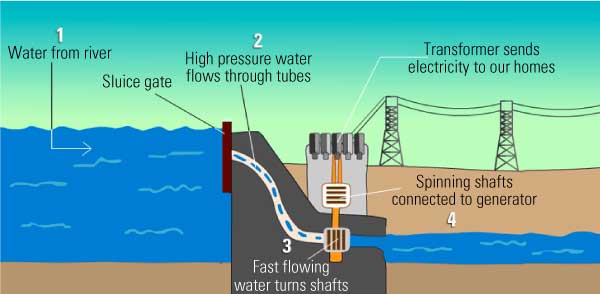- Renewable Energy
What is Water Power?
Moving water has Kinetic Energy. Kinetic Energy can be transferred into useful energy in different ways. Hydroelectric power (HEP) schemes store water high up in dams. The water has gravitational potential energy that is released when it falls.
Let’s see an example of how water can be used to generate electricity.

As the water rushes down through pipes, this stored energy is transferred to Kinetic Energy, which turns electricity generators.
- The dam is built to retain the water. More electricity is produced if the water is more in the reservoir
- Sluice Gates: These can open and close to regulate the amount of water that is released into the pipes.
- Potential Energy in the retained water is transferred into kinetic energy by water flowing through the pipes with high speed.
- The force and high pressure in the water turns a series of shafts in a generator. Spinning shafts in the generator charge millions of coils and magnets to create electricity, which is regulated by a transformer. This is then transported via cables to homes and factories.
To build a dam, there has to be valleys and rivers that flow all year round. This will help with the building and success of the dam as the fullest effect of the water’s kinetic energy can be tapped.
Global Distribution of Hydro-Power Generation Capacity.
Did you know?
- Hydropower is a renewable energy source that doesn’t cause global warming because it doesn’t release dangerous greenhouse gases.
- China is the largest producer of hydroelectricity, followed by Canada, Brazil, and the United States (Source: Energy Information Administration).
- Hydropower is the most important and widely-used renewable source of energy.
